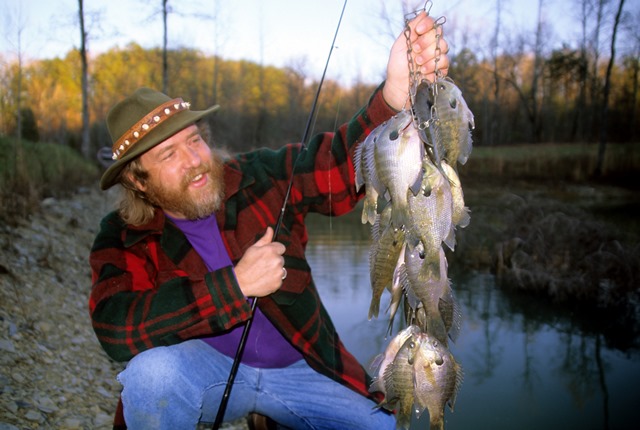
When summer has passed, many bluegill anglers store away their fishing tackle until the spring spawning season rolls around again. Interest wanes because most fishermen believe bluegills aren’t likely to bite when the water gets frigid.
Fortunately, the facts don’t jibe with that belief. Not only do bluegills feed actively throughout the cold months, this is an excellent time to catch dozens if you employ the right tactics.
I will not attempt to share ice-fishing tips. Yours truly lives in the South and so far I’ve never dropped a line through a hole in hard water. Many bluegill fans do; however, and enjoy great success fishing under the ice.
While I don’t ice fish, I do like targeting bluegills in December, January and February when the water is very cold. Catching big ‘gills this season can be challenging for sure. If the water temperature falls extremely low, these popular panfish may become so lethargic, it can be difficult to coax them to strike. Those that will hit may bite so gingerly they are almost undetectable. Overcoming these problems can be difficult, but the following tactics I’ve learned during years of winter bluegill fishing can help.
Fish on bottom in deep water.
You’re not likely to find winter bluegills in shallow shoreline cover. When the water cools, they move to deeper structure like creek channels, bluff edges, deep ends of points and deep holes in ponds. The best spots have timber, undercut banks, crevices between rocks and other cover where bluegills can hide from predators. A fish-finder and underwater camera can help you find these locales.
Because there are fewer insects for bluegills to eat, the fish change to a diet consisting largely of bottom invertebrates such as insect larvae, nymphs and various worms. Thus, you’ll usually catch more fish if you present your bait or lure directly on, or just inches above, the bottom.
Use the right enticements.
Your catch rate should also improve if you use live baits or lures resembling the bottom invertebrates winter bluegills relish. Small red wiggler worms weighted with just one or two tiny split shot are my favorite baits this season, but I’ve also enjoyed success fishing with tiny jigs, freshwater shrimp, mealworms, waxworms and crickets.
Wet flies resembling insect larvae and nymphs are especially effective. A sinking fly line can carry these patterns down where big bluegills are feeding, where you work them with little twitches the sight of such a fidgety tidbit tempts even the most jaded piscatorial taste buds.
If you try jigs, stick to the smallest sizes. In winter, I prefer 1/100- or 1/64-ounce leadheads because these tinier versions sink slower and more naturally. That can make an important difference in the catch rate when bluegills aren’t aggressive.
Here’s another trick. Tip your jig with a tiny piece of minnow for extra bream-catching pizzazz. Use a sharp knife to cut a fillet from the baitfish’s side, then divide it lengthwise into several small pieces. Very often, the added smell and taste is just what you need to coax whopper bluegill to nab your offering. You also can add a waxworm, mealworm or shot of fish attractant like Yum’s Crawfish Scent.
Use light tackle.
When fishing for deep winter bluegills, I prefer a 6- or 7-foot ultralight rod with a soft tip and a small spinning or underspin reel filled with 2-pound-test fluorocarbon or monofilament line. This rig exhibits sensitivity not found with larger tackle and permits you to detect the most delicate nibbles.
Four- to 6-pound-test line may seem small enough, but if panfish are finning their noses at your offerings, dropping to 2-pound-test can greatly increase your catch. Light line also permits longer casts with tiny panfish lures and small live baits. By keeping a distance from your fishing hole, you’re less likely to spook wary fish.
Be prepared for light bites.
The strikes of winter bluegills usually are “soft.” They feel like the hook has snagged a leaf. Be prepared to set the hook the instant your line goes slack or your bait doesn’t feel right. Don’t wait for anything else. Set the hook and note where the fish was when it struck. Where you catch one bluegill, you’ll usually find several more.
Try European-style floats.
If you like to fish with a float so you know when a fish bites, avoid plastic snap-on bobbers and foam or cork floats you peg on your line. Instead, try a European-style “antenna” float like Thill’s Super Shy Bite.
If a bluegill is feeding on or near the bottom and takes your bait, it may swim upward after inhaling the enticement. A regular bobber never moves, leading to missed fish. But a European-style float will signal a taker.
Attach the float to your line according to package directions. Then tie on a hook, and start adding small split-shot between the hook and float. Use just enough split shot so 1/4-inch of the bobber protrudes above the water when it floats. Now if a bluegill swims upward after grabbing the bait, it removes some weight off the line, and the super-sensitive bobber rises enough to clearly indicate a bite. Watch closely and be prepared to set the hook.
Vary your presentation.
On really tough days, you may find it’s little things that keep bluegills from biting. Take split shot for instance. When bream won’t bite, it may help to remove all split shot and try fishing wigglers, mealworms or waxworms without any weight. Many times this is all it takes to stir fish into action.
Another way to arouse the feeding instincts of persnickety winter bluegills is to slow your retrieve. Let’s say, for example, you’ve found bluegills suspended at mid-depths and are trying to catch them on a small spinner. In this case, you may need to move the lure at a snail’s pace to garner a strike. You can do this by rigging a sliding bobber on the line so the lure is suspended at the depth fish are holding. This allows you to slow your presentation and keep the spinner in the strike zone. Use a variety of retrieves—small twitches, a slow steady retrieve or long pulls with a few seconds of motionlessness between—until you determine the best pattern.
Trying new presentations like these may be just what the panfish doctor ordered.
Be flexible.
Regardless of the season, the key to finding and catching bluegills is flexibility. You must be willing to try different lures and baits, various depths, different types of cover and structure, and a variety of presentations until you strike pay dirt.
When you do establish a productive pattern, remember it for future reference. If you visit the same body of water, or one similar to it, during the same season under similar weather and water conditions, chances are good the same fishing pattern will bring you luck again.
And if the bluegills won’t bite? Well, kick back, relax, breathe some fresh air and enjoy yourself. They’ll start biting sooner or later. They always do. And when they do, you’ll have some fresh memories to remind you of the fun outing you had.

Enjoy Outdoor Recreational Activities at Fraser Island Australia Tours


Copyright © www.mycheapnfljerseys.com Outdoor sports All Rights Reserved